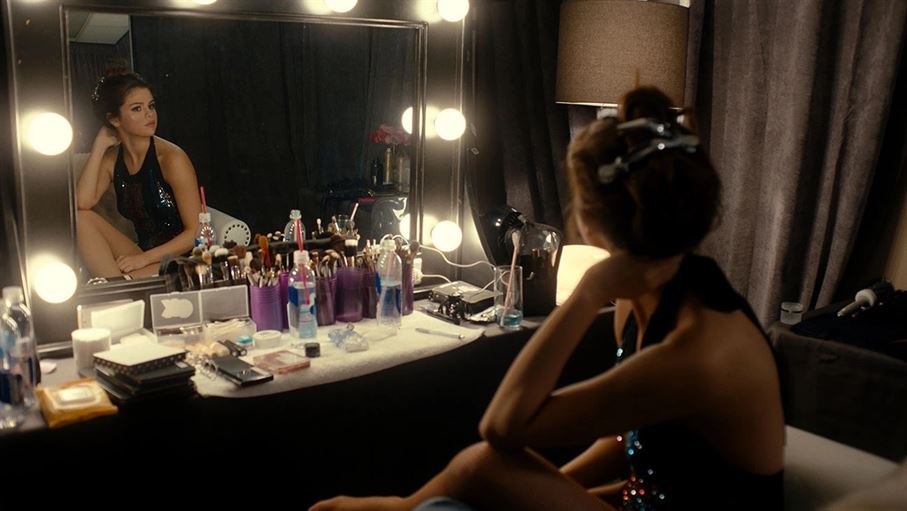In one of the very first lines of the documentary, “Selena Gomez: My Mind & Me,” the multi-talented star promises viewers one thing, “I’ll only tell you my darkest secrets.”
And one thing to be said, Gomez indeed kept that promise.
Directed by Alek Keshishian, who’s known for his groundbreaking work on “Madonna: Truth or Dare,” the documentary grants the world immeasurable access to Gomez’s life as it chronicles the reality of fame, mental health and lupus over six years.
Within the first 10 minutes, viewers are transported to 2016 and are met with one of the most emotionally naked moments as Gomez prepares for her “Revival” tour. Gomez breaks down in revulsion over her physical appearance and performance, stating she feels like she has the body of a “12-year-old boy” and is overwhelmed with haunting memories from her childhood Disney days.

Selena Gomez constantly faced body image issues.
Photo courtesy of Apple TV+
This jarringly raw scene is not only a testament to Gomez’s vulnerability but a deeper glimpse into the dark side of being a celebrity. In today’s society, there’s this obsession with wanting to be famous, but what many don’t see is the isolation that follows. Being a celebrity means you’re constantly working on the surface. You’re constantly working on how you appear.
Many lines go blurred, but Keshishian did an impeccable job illustrating that this life is not at all what it seems. And although being a celebrity and putting on a world tour seems like first-world problems, it causes unimaginable damage to one’s mental health.
The film proceeds, speeding through rehearsals, concerts, meet and greets and ambushes by paparazzi. But after 55 performances, the “Revival” tour was canceled. In the midst of all that, Gomez suffered a psychotic break, was diagnosed with lupus and underwent a kidney transplant.
None of this was presented on-screen but instead was replaced with input from family and friends. Some may be disappointed with this route, but honestly, it was the right choice. Although it’s an open and honest documentary, there’s a line that shouldn’t be crossed when it comes to privacy.
From there, we are transported again to 2019 where Gomez not only unveils her diagnosis of bipolar disorder but invites us a little deeper into her childhood through home videos and a very much-needed visit to her hometown of Grand Prairie, Texas.
From her old school and old neighbors to her family house where she wrote in her closet that she had a crush on Dylan and Cole Sprouse, this chunk of the film shines a light on who Gomez truly is instead of confining her to a diagnosis.
We get to see this extraordinary human who’s not ashamed of where she came from. With her status, it’s refreshing to see she doesn’t look down upon anyone but instead looks up to those around her. It’s a rare humbleness to witness.

Selena Gomez breaks down over her relationship with her biological father.
Photo courtesy of Apple TV+
Keshishian also makes sure to capture when Gomez addresses the disparity between a meticulously written public response regarding her mental health versus her true reality. Her willingness to do that is nothing less than admirable and is a notable aspect of the film.
While Keshishian does a great job at enclosing every moment, the cinematography isn’t all that revolutionary. But maybe that’s what makes it so good – the rawness. From the camera angles and wobbly movements to continuity and composition, the effect was powerful.
The film also features a series of flashing black-and-white clips of Gomez narrating her journal entries that are accompanied by thunderstorm soundscapes. This element truly allows for a strong impact and an innovative way of storytelling.
About midway through, we witness public speaking engagements about mental health, the making of her hit song “Lose You to Love Me,” her first performance in over two years, doctors appointments and a memorable trip to Kenya, Africa where she visited two schools that she helped raise money to build through the WE Charity.
But as they say, all good moments must come to an end. A European press tour triggered haunting memories from the past, and the coronavirus (COVID-19) pandemic made itself at home, driving Gomez into a state of anger and devastation. To top it off, she endured lupus flare-ups.
The way in which Keshishian encapsulated the exhaustion and pain that reeked from Gomez’s body was indescribable. It’s a two-minute compelling scene that will stay with many around the world.
At the end of all this, one thing is clear. One can have everything they’ve ever wanted, but they can be plagued by many obstacles.
It’s very simple for society to downplay the strength and courage it takes for a celebrity to be this transparent and vulnerable about their weaknesses. Gomez chose to show and tell the deepest parts of her identity on her own terms, and with that, she essentially took back control of her life.
She learned to choose herself and choose life.
“This does not make me faulty,” Gomez said. “This does not make me weak. This does not make me less than. This makes me human.”
She’s here on this earth not to be famous but to use her platform for good, and if it helps one person, that’s all that matters.



